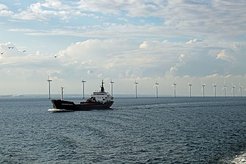Will wind energy in the German Bight approach a physical resource limit?

Today Agora Energiewende and Agora Verkehrswende released a report on offshore wind energy that brought together two groups of scientists who initially had rather different perspectives on wind resource estimation. The group of Dr. Axel Kleidon, an Earth system scientist at the Max-Planck-Institute for Biogeochemistry (MPI-BGC) in Jena, Germany, has previously argued for investigating the limits on wind energy. Because many wind turbines take out kinetic energy from the atmosphere, wind speeds slow down, lowering the efficiency of wind turbines and wind farms at large scales. This reduction can cause a relatively low wind energy potential per unit surface area of wind farms. Dr. Jake Badger, a wind energy expert from the Department of Wind Energy at the Technical University of Denmark (DTU Wind Energy), led the other group and brought in his experience of site-level assessments of wind energy potentials. He argued that large offshore wind farms can still be very effective in generating a lot of renewable energy at the right places. As it turns out, they now both agree that both their perspectives are valid. Offshore wind energy in the North Sea can contribute a lot of renewable energy, but weaker winds need to be considered in what to expect in scenarios for future offshore wind energy.
To get to their agreement, Badger and Kleidon’s groups jointly looked at how much electricity could potentially be generated by installing wind turbines in the German Bight region of the North Sea. Winds over the North Sea typically blow at higher speeds than over land, making it possible for wind turbines to generate more electricity offshore. German energy scenarios for the year 2050 plan for a substantial increase in offshore wind energy, with about eight times more capacity being installed in the German Bight over the next 30 years. The scientists considered a range of scenarios to cover also more extreme expansions of offshore wind energy so that they could find consistent trends in wind speeds and turbine efficiencies. These scenarios were evaluated with two, rather different methods. While Badger used a weather model, adapted to include the effect of wind farms, running on a supercomputer to simulate yields and how much winds slow down, Kleidon resorted to a budgeting model for the kinetic energy in a spreadsheet.
They both found the same trends: The more wind farms are installed within the German Bight, the weaker the winds become, lowering the average efficiency of the turbines. Kleidon explains: “Most of the wind energy that the turbines use in small or moderately small wind farms comes from the upwind regions, and not from the winds above. So the larger the wind farms extend along the downwind direction, the more the wind energy is depleted, causing wind speeds to drop.” Badger adds: “Despite these reductions, offshore wind has not reached its physical resource limit and can generate a lot of renewable energy efficiently in very large wind farms when suitably spacing the wind turbines.” In their calculations, both groups estimated that for the scenarios tested, offshore wind energy in the German Bight can potentially contribute up to half of the current German electricity needs. For the currently discussed and probably more economically viable scenarios, the teams estimated a contribution of about one third of the current German electricity needs.
Badger and Kleidon conclude that as wind energy is expanded in scale, these interactions with the atmosphere need to be accounted for. This, in turn, requires a broader planning process, in which not just the atmospheric effects of neighboring wind farms need to be considered, but also the expansion plans of the neighboring countries. There is plenty of wind energy available, but it requires careful planning and a broader look at the atmosphere to make the most out of it.
Original Publication
Agora Energiewende, Agora Verkehrswende, Technical University of Denmark and Max-Planck-Institute for Biogeochemistry (2020): Making the Most of Offshore Wind: Re-Evaluating the Potential of Offshore Wind in the German North Sea. https://www.agora-energiewende.de/en/publications/making-the-most-of-offshore-wind/
Contact info:
Dr. Axel Kleidon
Group leader, Biospheric Theory and Modelling
Max Planck Institute for Biogeochemistry
Jena, Germany
Phone: +49 3641 576217 E-mail: akleidon@bgc-jena.mpg.de
Dr. Jake Badger
Head of Section, Wind Resource Assessment Modelling
DTU Wind Energy
Technical University of Denmark
Risø, Denmark
Phone: +45 46775094
E-mail: jaba@dtu.dk
